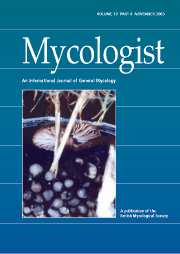Crossref Citations
This article has been cited by the following publications. This list is generated based on data provided by
Crossref.
2000.
21st Century Guidebook to Fungi.
p.
3.
Ritz, Karl
2006.
Fungi in Biogeochemical Cycles.
p.
51.
Fomina, Marina
Burford, Euan P.
and
Gadd, Geoffrey M.
2006.
Fungi in Biogeochemical Cycles.
p.
236.
Feeney, Debbie S.
Crawford, John W.
Daniell, Tim
Hallett, Paul D.
Nunan, Naoise
Ritz, Karl
Rivers, Mark
and
Young, Iain M.
2006.
Three-dimensional Microorganization of the Soil–Root–Microbe System.
Microbial Ecology,
Vol. 52,
Issue. 1,
p.
151.
Gaind, Sunita
and
Nain, Lata
2007.
Chemical and biological properties of wheat soil in response to paddy straw incorporation and its biodegradation by fungal inoculants.
Biodegradation,
Vol. 18,
Issue. 4,
p.
495.
Falconer, Ruth E.
Bown, James L.
White, Nia A.
and
Crawford, John W.
2007.
Biomass recycling: a key to efficient foraging by fungal colonies.
Oikos,
Vol. 116,
Issue. 9,
p.
1558.
Allton, Kathryn E.
Harris, James A.
Rickson, R. Jane
and
Ritz, Karl
2007.
The effect of microbial communities on soil hydrological processes: A microcosm study utilising simulated rainfall.
Geoderma,
Vol. 142,
Issue. 1-2,
p.
11.
Gadd, Geoffrey M.
2007.
Geomycology: biogeochemical transformations of rocks, minerals, metals and radionuclides by fungi, bioweathering and bioremediation.
Mycological Research,
Vol. 111,
Issue. 1,
p.
3.
Ritz, Karl
2007.
The Spatial Distribution of Microbes in the Environment.
p.
179.
Or, D.
Smets, B.F.
Wraith, J.M.
Dechesne, A.
and
Friedman, S.P.
2007.
Physical constraints affecting bacterial habitats and activity in unsaturated porous media – a review.
Advances in Water Resources,
Vol. 30,
Issue. 6-7,
p.
1505.
Falconer, Ruth E.
Bown, James L.
White, Nia A.
and
Crawford, John W.
2007.
Biomass recycling: a key to efficient foraging by fungal colonies.
Oikos,
Vol. 116,
Issue. 9,
p.
1558.
Young, I.M.
Crawford, J.W.
Nunan, N.
Otten, W.
and
Spiers, A.
2008.
Vol. 100,
Issue. ,
p.
81.
Falconer, Ruth E
Bown, James L
White, Nia A
and
Crawford, John W
2008.
Modelling interactions in fungi.
Journal of The Royal Society Interface,
Vol. 5,
Issue. 23,
p.
603.
Pagano, Marcela C.
Cabello, Marta N.
Bellote, Antonio F.
Sá, Nadja M.
and
Scotti, Maria Rita
2008.
Intercropping system of tropical leguminous species and Eucalyptus camaldulensis, inoculated with rhizobia and/or mycorrhizal fungi in semiarid Brazil.
Agroforestry Systems,
Vol. 74,
Issue. 3,
p.
231.
Kibblewhite, M.G
Ritz, K
and
Swift, M.J
2008.
Soil health in agricultural systems.
Philosophical Transactions of the Royal Society B: Biological Sciences,
Vol. 363,
Issue. 1492,
p.
685.
Boswell, Graeme P.
and
Hopkins, Steven
2008.
Linking hyphal growth to colony dynamics: Spatially explicit models of mycelia.
Fungal Ecology,
Vol. 1,
Issue. 4,
p.
143.
El-Said, A. H. M.
and
Saleem, A.
2008.
Ecological and Physiological Studies on Soil Fungi at Western Region, Libya.
Mycobiology,
Vol. 36,
Issue. 1,
p.
1.
Verheijen, F.G.A.
Jones, R.J.A.
Rickson, R.J.
and
Smith, C.J.
2009.
Tolerable versus actual soil erosion rates in Europe.
Earth-Science Reviews,
Vol. 94,
Issue. 1-4,
p.
23.
Jeffery, S.
Harris, J. A.
Rickson, R. J.
and
Ritz, K.
2010.
Effects of soil‐surface microbial community phenotype upon physical and hydrological properties of an arable soil: a microcosm study.
European Journal of Soil Science,
Vol. 61,
Issue. 4,
p.
493.
Gadd, Geoffrey Michael
2010.
Metals, minerals and microbes: geomicrobiology and bioremediation.
Microbiology,
Vol. 156,
Issue. 3,
p.
609.

